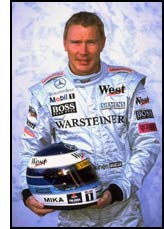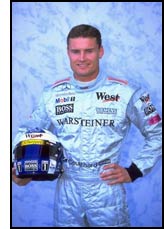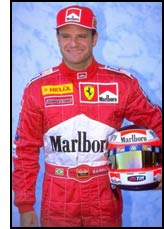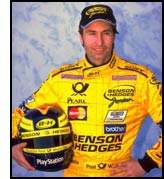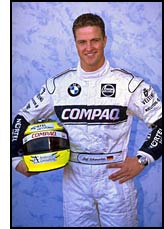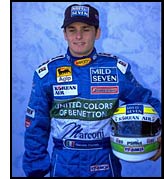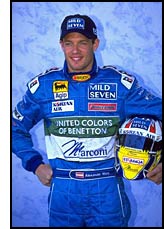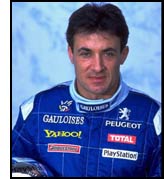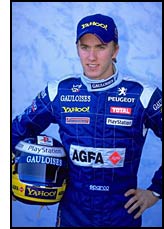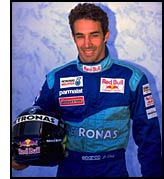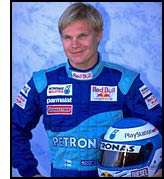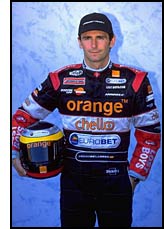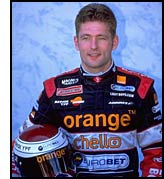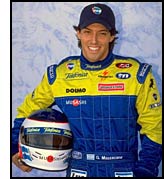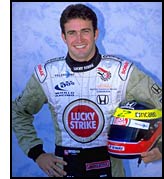| ATLAS F1 Volume 6, Issue 27 | |||
 |
The 2000 Season Mid-Term Report | ||
| By Mark Glendenning, Australia; Photo by Mark Thompson © Allsport |
|||
|
It's difficult to believe that the time has rolled around again already, but nevertheless, David Coulthard's superb victory at Magny Cours closed the curtains on the first half of the 2000 season. Normally, the Formula One championship has established some kind of rhythm by the end of the ninth round, but in 2000 one gets the feeling that it could be some time before the dust really settles. Like the last couple of years, we have Ferrari and McLaren setting the benchmark for everyone else. This time, though, the situation has been reversed. Ferrari spent the last few seasons chasing down their rivals - first Williams, then McLaren. This year, it was Ferrari who hit the ground running when the season began, and now they have to contend with trying to consolidate their advantage in the face of increasing pressure from Woking.
Even more intriguing is the battle on the next level down from the two leading teams. The gap between third and seventh or eighth has closed significantly this year - some of the teams who have fared well in recent years are struggling to find consistency, while some of the traditionally lesser teams have improved sufficiently to pose a threat if the conditions are right. Both the Drivers' and Constructors' Championships are still very much there for the taking; while the battle for supremacy in the midfield will be bitterly fought right down to the last round. All the unknowns will be answered in the next eight races; but for now, it's time to sit back and take stock of what's happened so far. The Mid-Term Report evaluates the performance of each driver during the first half of the year. Since the beginning of the season, I recorded the progress of the drivers, and, in the process, assigned grades at the end of each round. The grades ranged from A+ (for a sensational weekend), to F (for an absolute shocker). The scores were then averaged out to create an overall grade for the each driver. The drivers weren't penalized for problems that were clearly beyond their control (such as certain mechanical problems, or being wiped out by somebody else's overly-ambition overtaking move), and both qualifying and race results were taken into account. This year, we're also including the average qualifying and race positions for each driver - an idea born out of a suggestion sent to us by Atlas F1 reader Justin Carr. A couple of things should be clarified before we get underway. First, the report is intended as an evaluation of the extent to which the drivers have lived up to their potential. This includes both talent and the machinery that they have at their disposal. It is not intended as a measurement of one driver against another (except, to some extent, where teammates are concerned). Thus, what might count for a 'B+' for a Ferrari driver is very different to what might count for the same score where a Prost driver is concerned. Second, I elected to exclude retirements when calculating the figures for average finishing positions. Thus, the figure represents the average position a driver finishes in when they actually complete a race. For the most part, the figure is a fairly accurate representation of a typical performance by each driver, though it does flatter a few of the midfielders who have only seen the finish line in a handful of races. And now, finally, here is the Mid-Term Report: MCLAREN
One senses that Hakkinen is starting to appreciate why it's so rare for a driver to win three championships in succession. Mika has been hampered to some extent by mechanical difficulties, but even when the car has been in good shape he has been struggling to maintain his form of the past two years; particularly in qualifying. A strong performance in Spain proved that the Finn can still turn it on when he wants to, but unless he finds some consistency - and quickly - his dreams of a third title are going to slip through his fingers.
Hakkinen used to outqualify his teammate virtually as a formality, but Coulthard has had the measure of him over the past four races. Whatever the Scot did over his off-season break has worked wonders, for his performances have been among the year's greatest highlights to date. Coulthard has jumped out from Hakkinen's shadow with a newfound confidence and determination, and it is paying huge dividends. David notched up classy wins at Silverstone and Magny Cours, while his run to second at the Spanish Grand Prix while carrying broken ribs and the psychological after-effects of a plane crash only days before was inspiring. The penalty that arose from his stall on the grid at Canada could prove costly later in the season.
FERRARI
What we've seen of the 2000 season to date has been classic Schumacher. While some wins such as Australia were perhaps a little fortunate, his efforts at places like Imola, the Nurburgring, and Montreal illustrate Michael's confidence in both himself and his car. The latter is particularly significant, for it has generally been the machinery that has held him back from getting his seasons off to flying starts over the past couple of years. Whether the McLaren resurgence at Magny Cours represents a mere bump in the road or something more ominous for Schumacher remains to be seen; but either way, it's going to be fascinating to se how he deals with the challenge.
It's not easy being number #1a to Michael Schumacher. Just ask Rubens. Many people were excited by the prospect of finally seeing Barrichello in truly competitive machinery. Given the obvious strengths of this year's Ferrari though, it must be said that the Brazilian's efforts to date have been a little disappointing. There have been some real highlights; most notably the pole position at Silverstone, but other than that Barrichello's performances have been rather up and down. It's still quite possible that we'll see Rubens register his first win before the season is out, but it would be nice if he can do it with minimal assistance from his teammate.
JORDAN
2000 hasn't worked out quite the way many would have expected for Frentzen after his storming finish to the 1999 season. The temperamental Jordan certainly hasn't quite met his expectations, but silly mistakes such as crashing while running second with only eight laps to go at Monaco have also done little to help the cause.
Trulli is looking stronger every year. Watching his skills develop along with the likes of Ralf Schumacher and Fisichella suggest that Formula One may yet be in reasonably good hands once the Schumacher Snrs and Hakkinens of the world decide to do something else with their Sunday afternoons. Like Frentzen, the surprisingly fragile Jordan is doing Trulli few favours, but he is regularly in a position to scrap it out for a few points.
JAGUAR
Much in the style of BAR last year, the big cat seems to have tripped over its own tail. Irvine worked hard for a well-deserved fourth place at Monaco, but everything else has been a struggle. Right now, the Jaguar is simply not up to the task; until it is, Irvine has a lot of difficult Grands Prix ahead. At least his boat still works OK.
And if any further proof of the Jaguar's evils is needed, you could always seek out Johnny Herbert. There is little that can be said about Herbert and bad luck that hasn't already been said a thousand times in the past couple of years, and 2000 again sees the cheerful Englishman bearing the brunt of most of the team's teething problems. This could well be Johnny's last year in Formula One, and it would be nice if the second half of the season saw the car hold remain intact long enough for him to string a couple of decent performances together.
WILLIAMS
Little was expected from Ralf Schumacher in 2000 as Williams and BMW slowly settle down and get to know one another. His results have subsequently taken everyone by surprise. While the Williams is not competitive everywhere just yet, Ralf's driving can generally be relied on as a reasonable indicator of the car's potential. He recovered well from a nasty crash at Ste Devote during the Monaco Grand Prix, an incident that is the only really significant blight on his season so far. Schumacher has finished in the points in more than half his races this year, and has retired from potential point-scoring positions on a couple of occasions; the most memorable being Canada when he was the innocent victim of an ambitious yet somewhat misjudged move by Villeneuve.
In terms of hype, nobody on the F1 grid can hold a candle to Jenson Button; at least where the British press are concerned. For the most part, Button has done enough to, if not silence his critics, then at least buy himself some time. He was impressive in Australia, particularly in light of the rather minimal amount of track time he had prior to qualifying. Elsewhere, good drives at Silverstone and Interlagos suggested that he is capable of holding his own, though Monaco and the Nurburgring indicated that he still has some work to do.
BENETTON
Fisichella is driving magnificently this year. At times he has managed to drag the Benetton into places that it really has no right to be, and in the process he's completely consolidated his supremacy over Wurz. Had weekends to forget in San Marino and Spain, but the Italian has otherwise been a consistent point scorer and has also snuck in three podiums, despite having qualified no higher than fifth.
When I think of Alexander Wurz, I think of two things. The first is the amazing job he did when he spent three races as Gerhard Berger's understudy in 1997. The second is his great battle with Michael Schumacher at Monaco in 1998. And that's the problem. In the ensuing two years, he has been distinctly unremarkable. His height may perhaps be something of a disadvantage, but he's not exactly the first tall Formula One driver in recent history. The signs are that Benetton might be making a slow comeback, and they're only going to get stronger when Renault enters the picture. It could be a good place to be in the next few years, but Wurz has a lot of work to do if he wants to remain a part of it.
PROST
Benetton might be on the rise, but Prost is alternating between standing still and moving backwards. It's not the ideal situation you'd want to be in when you're approaching the end of your career, and it's certainly not making life easy for Jean Alesi at the moment. Alesi is doing the best with what he's got, but he really has very little to work with. A great qualifying effort at Monaco amounted to little when the car gave up on lap 29.
The publicity surrounding Button's Formula One debut allowed Heidfeld to slip into his role at Prost almost unnoticed, at least by the English-speaking press. This probably suited both drivers quite well - Jenson loves the attention, while Heidfeld seems to genuinely prefer to be left alone to get on with his racing. Given the way his debut season is shaping up, the relative absence of media attention has probably turned out to be a blessing. The Prost is not an easy car in which to make a great impression, and the situation is further complicated by the young German's 'on-loan' status with the team. He's had so little track time that it's difficult to really evaluate him. Outqualifying his vastly more experienced teammate on debut was probably the major highlight in what has otherwise been a depressing stream of disqualifications, team errors, mechanical failures, and the occasional ten-second penalty.
SAUBER
Last year, it seemed that Diniz had finally shaken off the rent-a-driver tag and established himself as a respectable if not spectacular Formula One driver. This year though, he seems to be simply making up the numbers again. He was unfortunate to miss his home Grand Prix after Sauber withdrew both of their cars for safety reasons, but elsewhere he has made several contributions to his own decline. Several races have found the Brazilian making unforced errors, while even the high-attrition races have seen him make little impact. That said, the Sauber has not proved to be most forgiving piece of equipment on the grid, which has not helped Pedro much.
Salo has done well to score a few points for Sauber this year, because he's certainly not driving one of the more competitive cars around. Several races have seen the Finn put in fairly strong performances that fell short of scoring points simply because the car wasn't capable of really taking the fight to his opponents, but overall Mika is doing as solid a job as could be expected.
ARROWS
There's no doubting that de la Rosa is good - when he manages to finish a race, he usually finishes in a fairly strong position. The problem, though, is that he fails to finish far too often. Sometimes he gets himself into trouble, other times he is simply in the wrong place when somebody else overestimates their abilities. The Arrows is a reasonable car this year, and if the young Spaniard can take advantage of it then he is capable of posting some good results. But unless he can start regularly ending races by crossing the finish line rather than hanging around a gravel trap trying to hitch a lift back to the pits, his talent will go to waste.
Much to the surprise of almost everybody, the Dutchman is having a fairly good year. Occasionally the car has let him down, and there has been the odd excursion off the circuit to remind us of the Verstappen of old, but for the most part Jos has looked reasonably strong. His amazing effort in Canada was probably the highlight of the whole race. The vast improvements made by Arrows has no doubt played some role, for it is a far more competitive car than the Tyrrell that Verstappen was piloting during his last stint as a racer.
MINARDI
Minardi have apparently made another few steps forward this year. They're still firmly entrenched in the tail end of the grid, though the overall gap between them and the front-runners seems to have closed slightly. While the period of relative stability in the technical regulations over the past couple of years has contributed to this, the folk from Faenza still seem to have produced their best car in quite a while. Gene's year has been a bit up and down - while some races see the Spaniard put in a fairly honest weekend's work, there other occasions where it seems that he just can't keep the thing out of the gravel.
Half a season in a Minardi doesn't give a driver much opportunity to make waves, and as such it's hard to evaluate Mazzacane. He has rarely been able to outrace his teammate, and tends to be a few tenths slower in qualifying. Nevertheless, a couple of solid drives on days when many more highly rated drivers have failed to finish suggest that he's at least capable of holding it together in a high attrition race to take advantage of any stray points that may go begging.
BRITISH AMERICAN RACING
BAR have made huge steps this year. The team may not have progressed enough to allow Villeneuve to compete at the level he wants to, but he's at least got a car that will allow him to make regular excursions into the top 6 during a race. The car still has some way to go yet, particularly where reliability is concerned, but the difference between Villeneuve circa mid-1999 and Villeneuve right now is like night and day. He's still subject to what has become a traditional brainfade at his home Grand Prix, which this year manifested itself as a banzai move on Coulthard at the hairpin that saw the Canadian shoot straight past his quarry and plant himself gracefully into the flank of the Williams of Ralf Schumacher. Now all we have to do is wait and see how many spare cars BAR take to Spa in anticipation of Villeneuve's efforts to take Eau Rouge flat.
Zonta has been completely outclassed by his teammate this year, both in qualifying and race trim. The Brazilian scored a lucky point following Salo's disqualification in Australia, and had reasonable races at Canada and Spain, but the rest of the season has been unremarkable.
| ||||||||||||||||||||||||||||||||||||||||||||||||||||||||||||||||||||||||||||||||||||||||||||||||||||||||||||||||||||||||||||||||||||||||||||||||||||||||||||||||||||||||||||||||||||||||||||||||||||||||||||||||||||||||||||||||||||||||||||||||||||||||||||||||||||||||||||||||||||||||||||||||||||||||||||||||||||||||||||||||||||||||||
| Mark Glendenning | © 2000 Kaizar.Com, Incorporated. |
| Send comments to: glendenning@atlasf1.com | Terms & Conditions |
